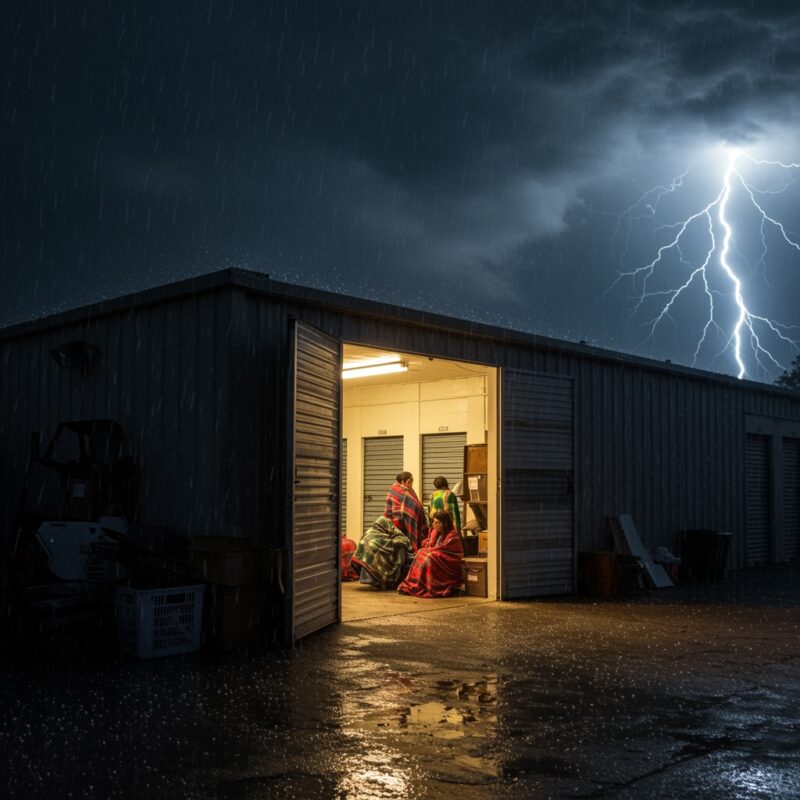Storm Warning – Self-Storage Returns

Tornado Alerts and Market Meltdowns: Why Smart Investors Seek Shelter
My family and I had been excited about our spring break trip for months—ten days of freedom, exploration, and adventure in our RV. The kids were thrilled: hiking through Kentucky’s lush trails, cooking over the campfire, and escaping the routines of school and screens. We had a solid plan, a stocked pantry, and a carefully mapped route. But as any seasoned traveler knows, no amount of preparation can fully shield you from life’s surprises.
By the third day, the weather turned ominous. The cheerful drizzle that had accompanied our morning hike escalated into something far more threatening. Dark clouds rolled in, the wind howled against the RV’s thin walls, and our phones buzzed with urgent alerts: severe thunderstorms, potential hail, and—most concerning—a tornado warning at 2 AM. Suddenly, our cozy family trip became a lesson in weathering the unexpected.
Huddled in the RV, and concerned about managing our children’s worst fears, listening to the storm rage outside, I couldn’t help but think about how life—and investing—often mirrors this scenario. We see the warning signs (inflation, market volatility, economic uncertainty), but when the storm hits, we’re forced to react. Some panic. Some freeze. And the smart ones? They find shelter.
That’s exactly what self-storage represents in today’s turbulent economy: a resilient, often overlooked shelter for investors.
Investors have been experiencing this as the stock market keeps delivering its own version of extreme weather. Just last week, the Dow nose dived on the tariff news. The VIX volatility index has been spiking like a tornado warning siren. And like my family in that RV, many investors are realizing their portfolios have nowhere to hide when the financial storms hit.
But here’s what I learned from both experiences: When you can’t control the storm, you control your shelter. While growth stocks and crypto were getting tossed around, one unglamorous sector has been quietly weathering every squall – self storage. Like our RV’s sturdy frame, it’s built to handle turbulence. Here’s why…
Storage’s Shock Absorbers – The Unique Economics That Smooth Out Volatility
The Counter-Cycle Superpower
Self-storage thrives when life gets messy—and 2025 is getting very messy:
| Crisis | How Storage Benefits |
|---|---|
| Housing crunch | More renters = more storage needs |
| Job instability | Downsizing = storage demand spike |
| Remote work | Home offices need space |
| E-commerce boom | Micro-businesses need inventory space |
Real-world proof: During 2008-2010, while REITs overall fell 37%, storage REITs GAINED 28%.
The “Toothpaste Tube” Effect
Unlike discretionary spending (restaurants, travel), storage is what economists call “price inelastic”—people pay even when it hurts:
- 92% occupancy rates through recessions
- Rent hikes stick (7-12% annually) because…
- $150/month feels cheap vs. moving to a bigger home
“Our customers don’t leave—they just complain on Yelp while auto-paying.”
The Market’s Rollercoaster – Why Traditional Portfolios Are Getting Rocked
This year has been a masterclass in volatility:
- The Magnificent 7 lost their halo – After carrying markets, tech giants like Nvidia, Tesla and Apple have swung wildly on AI hype vs. reality checks
- The Fed’s “higher for longer” hammer – Every jobs report, CPI release and tariff tweet sparks violent rate-cut speculation
- Geopolitical lightning strikes – From oil shocks to shipping crises, black swans keep coming
Why Diversification Failed (Again)
Traditional 60/40 stock-bond portfolios face headwinds as bonds struggle to counterbalance equity declines amid inflation and fiscal uncertainty5. With rising government debt and interest rate volatility, bonds no longer reliably act as a “life-raft” during market turbulence, forcing investors to seek alternative hedges like gold or catastrophe bonds
Shifts in U.S. trade policy (e.g., potential Trump-era tariffs), China’s economic fragility, and interest rate unpredictability have introduced new correlations between asset classes, reducing the effectiveness of traditional diversification35. For example, tariffs could simultaneously impact equities, currencies, and commodities, weakening portfolio resilience
The painful truth: Most investors’ portfolios are still built for sunny days.

How to Invest in Self-Storage (Without Owning a Facility)
Option 1: Storage REITs (The Hands-Off Approach)
Real Estate Investment Trusts (REITs) like Public Storage (PSA), Extra Space (EXR), and CubeSmart (CUBE) let you invest in storage portfolios without managing properties.
- Pros: Liquidity, dividends, and professional management.
- Cons: Market correlation (though historically less volatile than other REITs).
Performance check: Storage REITs outperformed the S&P 500 in 7 of the last 10 years, including during 2022’s market crash.
Option 2: Private Syndications (Higher Returns, Higher Risk)
For accredited investors, private storage funds offer 11-15% annual returns by acquiring undervalued facilities.
- Pros: Inflation-linked rent growth, asset control.
- Cons: Illiquidity, longer hold periods (5+ years).
Option 3: DIY Ownership (For the Entrepreneurial Investor)
If you’re hands-on, buying a small facility or converting vacant retail space can yield 20%+ cash-on-cash returns.
- Key tip: Focus on secondary markets (e.g., Midwest, Sun Belt) where demand outpaces supply.
Finding Shelter in the Storm
Back in that Kentucky RV, as the storm finally passed and we stepped outside to assess the damage (minimal, thankfully), I realized something: resilience isn’t about avoiding disasters—it’s about positioning yourself to endure them.
Self-storage isn’t glamorous. It won’t make headlines like AI stocks or crypto. But like our RV’s sturdy walls, it offers something invaluable in chaotic times: dependability. Whether through REITs, private deals, or direct ownership, storage investing lets you profit from the very economic pressures crushing other assets.
So as inflation lingers and markets wobble, ask yourself: Where’s your portfolio’s shelter?

